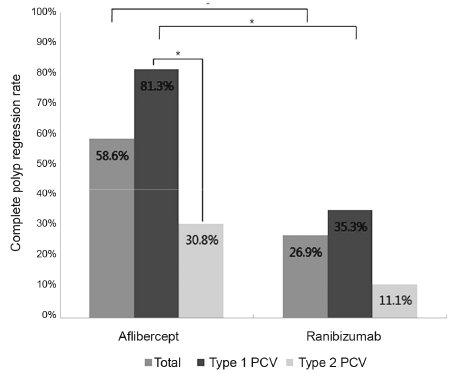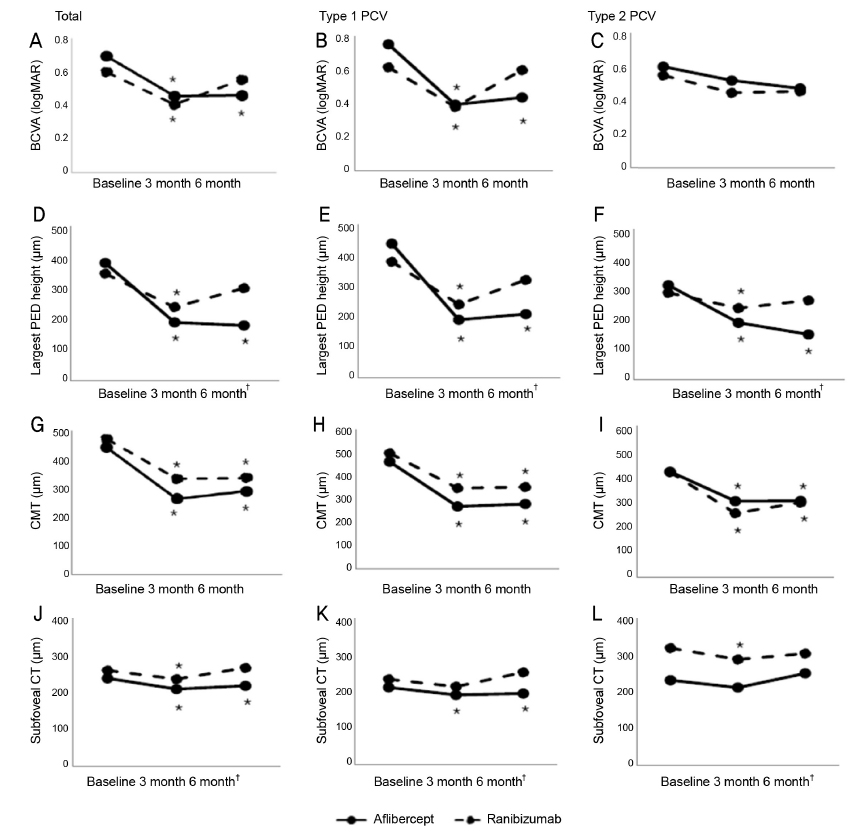J Korean Ophthalmol Soc.
2017 Dec;58(12):1356-1366. 10.3341/jkos.2017.58.12.1356.
A Comparison of Efficacies of Aflibercept and Ranibizumab, Depending on the Angiographic Classification of Polypoidal Choroidal Vasculopathy
- Affiliations
-
- 1Department of Ophthalmology, Yeungnam University College of Medicine, Daegu, Korea. msagong@ynu.ac.kr
- KMID: 2397850
- DOI: http://doi.org/10.3341/jkos.2017.58.12.1356
Abstract
- PURPOSE
To compare the short-term efficacy of intravitreal aflibercept and ranibizumab treatment according to the subtypes of polypoidal choroidal vasculopathy (PCV) based on indocyanine green angiography (ICGA).
METHODS
Fifty-five treatment naïve patients with PCV who underwent intravitreal anti-vascular endothelial growth factor (VEGF) (ranibizumab, 26 eyes; aflibercept, 29 eyes) injection were retrospectively analyzed. Based on ICGA, subjects with feeder and draining vessels were defined as type 1 PCV (33 eyes), and subjects who did not have either feeder or draining vessels, but had branch vascular networks were defined as type 2 PCV (22 eyes). The complete polyp regression was assessed at 3 months after the initial treatment using ICGA. Changes in best-corrected visual acuity (BCVA) and optical coherence tomographic parameters were evaluated at 3 and 6 months.
RESULTS
Patients with type 1 PCV showed a higher complete polyp regression percentage (p = 0.034) and better visual improvement (p = 0.017) after three monthly injections compared to patients with Type 2 PCV. At 3 and 6 months, the BCVA was significantly improved in type 1 PCV patients, but not in type 2 PCV patients. In patients with type 1 PCV, the aflibercept-treated group showed a better response in anatomical outcomes (p = 0.020), and complete polyp regression percentage (p = 0.027; dry macula) than the ranibizumab-treated group, and only the aflibercept-treated group showed a significant improvement of BCVA at 3 and 6 months. In patients with type 2 PCV, there were no significant differences in visual and anatomical outcome between the anti-VEGF agents.
CONCLUSIONS
Type 1 PCV showed better visual improvement with a higher percentage of polyp regression than type 2 PCV. Anatomical changes were greater in patients treated with aflibercept than with ranibizumab, particularly in patients with type 1 PCV. These results suggest that a consideration of angiographic features is important in establishing a treatment strategy for patients with PCV.
Keyword
MeSH Terms
Figure
Reference
-
1. Yannuzzi LA, Sorenson J, Spaide RF, Lipson B. Idiopathic polypoidal choroidal vasculopathy (IPCV). Retina. 1990; 10:1–8.2. Spaide RF, Yannuzzi LA, Slakter JS, et al. Indocyanine green videoangiography of idiopathic polypoidal choroidal vasculopathy. Retina. 1995; 15:100–110.3. Cho HJ, Kim JW, Lee DW, et al. Intravitreal bevacizumab and ranibizumab injections for patients with polypoidal choroidal vasculopathy. Eye (Lond). 2012; 26:426–433.4. Koh A, Lee WK, Chen LJ, et al. EVEREST study: efficacy and safety of verteporfin photodynamic therapy in combination with ranibizumab or alone versus ranibizumab monotherapy in patients with symptomatic macular polypoidal choroidal vasculopathy. Retina. 2012; 32:1453–1464.5. Koh AH, Chen LJ, Chen SJ, et al. Polypoidal choroidal vasculopathy: evidence-based guidelines for clinical diagnosis and treatment. Retina. 2013; 33:686–716.6. Stewart MW. Aflibercept (VEGF Trap-eye): the newest anti-VEGF drug. Br J Ophthalmol. 2012; 96:1157–1158.7. Tan CS, Lim TH, Hariprasad SM. Current management of polypoidal choroidal vasculopathy. Ophthalmic Surg Lasers Imaging Retina. 2015; 46:786–791.8. Dhalla MS, Shah GK, Blinder KJ, et al. Combined photodynamic therapy with verteporfin and intravitreal bevacizumab for choroidal neovascularization in age-related macular degeneration. Retina. 2006; 26:988–993.9. Wong CW, Yanagi Y, Lee WK, et al. Age-related macular degeneration and polypoidal choroidal vasculopathy in Asians. Prog Retin Eye Res. 2016; 53:107–139.10. Inoue M, Yamane S, Taoka R, et al. Aflibercept for polypoidal choroidal vasculopathy: as needed versus fixed interval dosing. Retina. 2016; 36:1527–1534.11. Introini U, Casalino G, Triolo G, et al. Stereotactic radiotherapy for polypoidal choroidal vasculopathy: a pilot study. Ophthalmologica. 2015; 233:82–88.12. Oishi A, Tsujikawa A, Yamashiro K, et al. One-year result of aflibercept treatment on age-related macular degeneration and predictive factors for visual outcome. Am J Ophthalmol. 2015; 159:853–860.e1.13. Yamamoto A, Okada AA, Kano M, et al. One-year results of intravitreal aflibercept for polypoidal choroidal vasculopathy. Ophthalmology. 2015; 122:1866–1872.14. Takayama K, Kaneko H, Kataoka K, et al. Comparison between 1-year outcomes of aflibercept with and without photodynamic therapy for polypoidal choroidal vasculopathy: Retrospective observation study. PloS one. 2017; 12:e0176100.15. Kawamura A, Yuzawa M, Mori R, et al. Indocyanine green angiographic and optical coherence tomographic findings support classification of polypoidal choroidal vasculopathy into two types. Acta ophthalmol. 2013; 91:e474–e481.16. Yuzawa M, Mori R, Kawamura A. The origins of polypoidal choroidal vasculopathy. Br J Ophthalmol. 2005; 89:602–607.17. Tsujikawa A, Sasahara M, Otani A, et al. Pigment epithelial detachment in polypoidal choroidal vasculopathy. Am J Ophthalmol. 2007; 143:102–111.18. Tong JP, Chan WM, Liu DT, et al. Aqueous humor levels of vascular endothelial growth factor and pigment epithelium–derived factor in polypoidal choroidal vasculopathy and choroidal neovascularization. Am J Ophthalmol. 2006; 141:456–462.19. Tan CS, Ngo WK, Lim LW, Lim TH. A novel classification of the vascular patterns of polypoidal choroidal vasculopathy and its relation to clinical outcomes. Br J Ophthalmol. 2014; 98:1528–1533.20. Sasahara M, Tsujikawa A, Musashi K, et al. Polypoidal choroidal vasculopathy with choroidal vascular hyperpermeability. Am J Ophthalmol. 2006; 142:601–607.21. Matsumiya W, Honda S, Otsuka K, et al. Comparison of the effectiveness and prognostic factors of intravitreal ranibizumab between typical neovascular age-related macular degeneration and polypoidal choroidal vasculopathy over 24 months of follow-up. Ophthalmologica. 2015; 234:33–39.22. Koizumi H, Yamagishi T, Yamazaki T, Kinoshita S. Relationship between clinical characteristics of polypoidal choroidal vasculopathy and choroidal vascular hyperpermeability. Am J Ophthalmol. 2013; 155:305–313.e1.23. Kim JH, Lee TG, Chang YS, et al. Short-term choroidal thickness changes in patients treated with either ranibizumab or aflibercept: a comparative study. Br J Ophthalmol. 2016; 100:1634–1639.24. Jeong S, Sagong M. Short-term efficacy of intravitreal aflibercept depending on angiographic classification of polypoidal choroidal vasculopathy. Br J Ophthalmol. 2017; 101:758–763.25. Lee D, Jeong S, Moon J, et al. Analysis of efficacy of intravitreal aflibercept according to subfoveal choroidal thickness in polypoidal choroidal vasculopathy. J Korean Ophthalmol Soc. 2016; 57:1577–1585.26. Coscas G, Lupidi M, Coscas F, et al. Toward a specific classification of polypoidal choroidal vasculopathy: idiopathic disease or subtype of age-related macular degeneration. Invest Ophthalmol Vis Sci. 2015; 56:3187–3195.27. Chung SE, Kang SW, Lee JH, Kim YT. Choroidal thickness in polypoidal choroidal vasculopathy and exudative age-related macular degeneration. Ophthalmology. 2011; 118:840–845.28. Klettner A, Recber M, Roider J. Comparison of the efficacy of aflibercept, ranibizumab, and bevacizumab in an RPE/choroid organ culture. Graefes Arch Clin Exp Ophthalmol. 2014; 252:1593–1598.29. Lommatzsch A, Heimes B, Gutfleisch M, et al. Serous pigment epithelial detachment in age-related macular degeneration: comparison of different treatments. Eye (Lond). 2009; 23:2163–2168.30. Browning DJ, Kaiser PK, Rosenfeld PJ, Stewart MW. Aflibercept for age-related macular degeneration: a game-changer or quiet addition? Am J Ophthalmol. 2012; 154:222–226.31. Nomura Y, Kaneko M, Miyata K, et al. Bevacizumab and aflibercept activate platelets via FcγRIIa. Invest Ophthalmol Vis Sci. 2015; 56:8075–8082.32. Julien S, Biesemeier A, Taubitz T, Schraermeyer U. Different effects of intravitreally injected ranibizumab and aflibercept on retinal and choroidal tissues of monkey eyes. Br J Ophthalmol. 2014; 98:813–825.
- Full Text Links
- Actions
-
Cited
- CITED
-
- Close
- Share
- Similar articles
-
- Initial Factors Associated with Resistance to Intravitreal Aflibercept Injection in Polypoidal Choroidal Vasculopathy
- Comparison of Choroidal Thickness Change between Ranibizumab and Aflibercept in Age-related Macular Degeneration: Six Month Results
- Long-term Treatment Outcome of Intravitreal Aflibercept Monotherapy for Polypoidal Choroidal Vasculopathy
- Aflibercept Treatment for Neovascular Age-related Macular Degeneration and Polypoidal Choroidal Vasculopathy Refractory to Anti-vascular Endothelial Growth Factor
- Clinical Outcomes of Switching to Brolucizumab in Refractory Polypoidal Choroidal Vasculopathy Treated with Aflibercept




